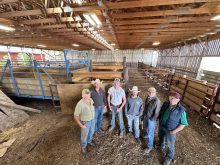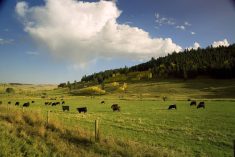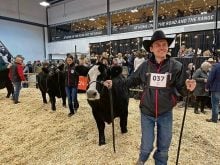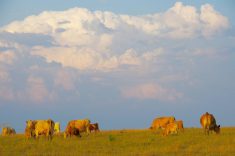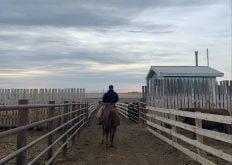A new research project aims to help beef producers better interpret the production data they’re already collecting to make informed management decisions.
Currently in its first stages of development, the Arm-Chair Rancher mobile application, a collaboration between Livestock Gentec and David Wishart, professor of biology at the University of Alberta, will analyze data on production traits, genetics and economics to provide tailored recommendations to beef producers.
“An important element will be framing on-farm data with information from all of the other relevant sources, including weather, prices and trends and to bring it all to one place to answer the issue facing the producer at different times,” says Graham Plastow, CEO of Livestock Gentec and professor in animal genomics at the University of Alberta.
Read Also

Building demand together: The impact of Canada’s beef import levy
The beef import levy has become a central tool for ensuring balance in Canada’s beef industry
Plastow says that while we collect a lot of data on ranches, “we’ve not necessarily been able to use all of it or been able to interpret that information.”
Livestock Gentec has collaborated on previous projects with Wishart’s team, and the latter has made strides in artificial intelligence and machine learning. In discussing the data capture and analysis technologies used in other industries and the need for these tools in beef production, the researchers decided to create a proposal for a mobile app.
Made possible by funding from the Smart Agriculture and Food Digitization and Automation Challenge, an Alberta Innovates initiative, this endeavour is a three-year research project. Plastow anticipates that beta testing and the launch of the app will take place in the third year.
In addition to using tools developed by Wishart in other fields to mine information electronically, the app will need to capture the data already tracked by producers through other software programs. “We will be looking to work with the industry partners to capture that data into the databases,” says Plastow.
“We’re trying to avoid duplication, so producers being able to continue to use some of the systems they’re using already to interface with the app is important.”
The team also plans to form an advisory group of ranchers to help them “understand the sort of questions they’re asking and for us to be able to develop the app in a way that makes sense for them,” he explains.
Plastow highlights the importance of capturing data that’s specific to an individual ranch to allow for more accurate data analysis, rather than just offering averages for the province. “What we’d love to be able to do is to produce a tailored solution for that particular ranch,” he says, noting that this will require producers to participate and share their data.
The researchers are mindful of protecting producers’ information as they use this app. “One of the things we will do is, as people are putting data into the database, we will be anonymizing that data, so that will be one of the mechanisms that will protect peoples’ information,” says Plastow.
Based on the use of smart technologies in the dairy industry to capture production data, for example, Plastow sees many opportunities for the beef industry to leverage data in ways that haven’t been possible before due to the nature of beef production in Western Canada.
“There are new technologies coming, which I think will tie into where we’re going with the project,” he says. “We’ll be able to capture information on our beef animals, much more information than we have been in the past. The cost of technology will come down, and it will provide us with more information on what is happening.”
Exploring data capture and analysis technologies
The rising interest in smart agriculture technologies is illustrated in the creation of the Pan-Canadian Smart Farm Network, a partnership between Olds College at Olds, Alta., Lakeland College at Vermillion, Alta. and Glacier FarmMedia Discovery Farm at Langham, Sask.
Supported by $1.1 million in funding by the Canadian Agri-Food Automation and Intelligence Network, this initiative is “committed to sharing data and expertise that will help farmers, industry and technology developers better understand, utilize and develop smart ag technologies,” says Joy Agnew, associate vice-president of applied research at Olds College.
The goal is to expand the network across Canada to allow for data on different geographic regions and production systems, Agnew explains. “Producers are ultimately going to benefit from the network activities by their ability to access unbiased information on the value of current and leading-edge technology for their farm,” she says. Information will be shared through a variety of forms, including fact sheets, webinars and videos.
These technologies “have the ability to collect tremendous amounts of data, but data can be overwhelming on its own,” says Blake Weiseth, applied research lead at Glacier FarmMedia Discovery Farm. “I think the great opportunity in this network is we’re collaborating with our industry partners who have a lot of tools already existing or are in the process of developing new tools. That’s where the value is added to the data to help producers make meaningful decisions in the season.”
There’s also a focus on helping producers receive a better return on investment when trying these new technologies. “With one growing season or one production cycle, it’s always high risk if things don’t work out,” says Agnew. “All of these technologies are developed elsewhere in the world for different production types, so we want Canadian producers to understand how those technologies would apply for them.”
By beta testing these tolls through the network’s smart farm, the companies involved can also get a better understanding of how these technologies work in a real-world setting, says Josie Van Lent, dean of agriculture technology and applied research at Lakeland College.
“All three of us are working with different companies in beta testing their technologies on-farm, and in some cases the companies have less of an ag background, and that’s the beauty in the partnership is we can bring that agriculture piece in a really robust way and help them to implement their technology on farm.”
While the first project running at each Smart Farm Network site is focused on crop production, Agnew says they plan to extend their testing to livestock production technologies, with research at Olds College Smart Farm focusing on the “development of artificial intelligence and machine learning for cattle identification and animal health identification in real-time.”





